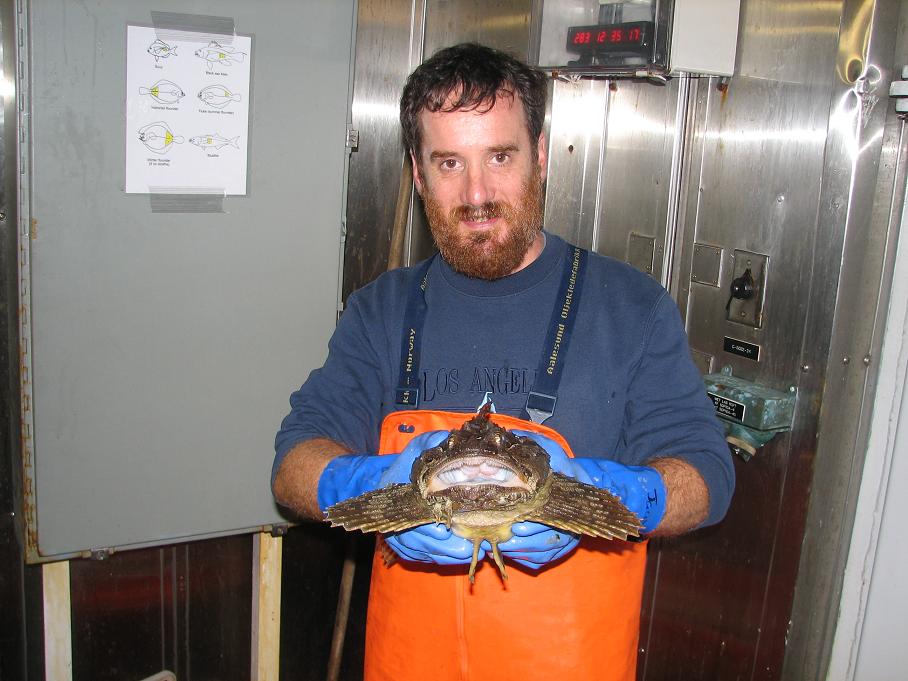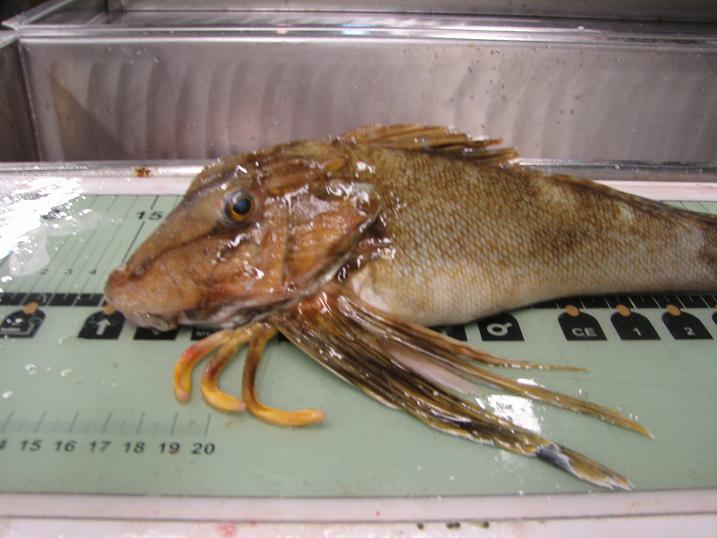
Friday, October 10, 2008
Let's Look at some Sea Creatures in Detail
Did you figure out the answer to yesterday's question? Those creatures were the real cast of Sponge Bob Square Pants TV Show. We saw a sponge, like Sponge B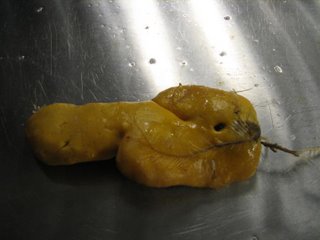 ob, and sea stars like Patrick, plankton, like Sheldon Plankton, some squid like Squidward, a crab like Mr. Krabs next to a sand dollar (because Mr. Krabs loves money), a lobster like Larry the Lobster and a snail like Gary. All the creatures in the program actually exist in the sea, except for squirrels, and we have seen them all on this adventure.
ob, and sea stars like Patrick, plankton, like Sheldon Plankton, some squid like Squidward, a crab like Mr. Krabs next to a sand dollar (because Mr. Krabs loves money), a lobster like Larry the Lobster and a snail like Gary. All the creatures in the program actually exist in the sea, except for squirrels, and we have seen them all on this adventure.
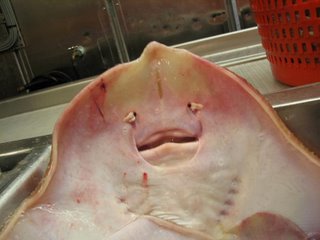
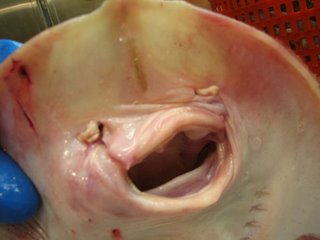
This sea robin uses three separate parts of its pectoral fin, called fin-rays to move, almost like its walking along the bottom of the sea as it looks for food. This helps is move very quietly, making it able to sneak up on prey unobserved.
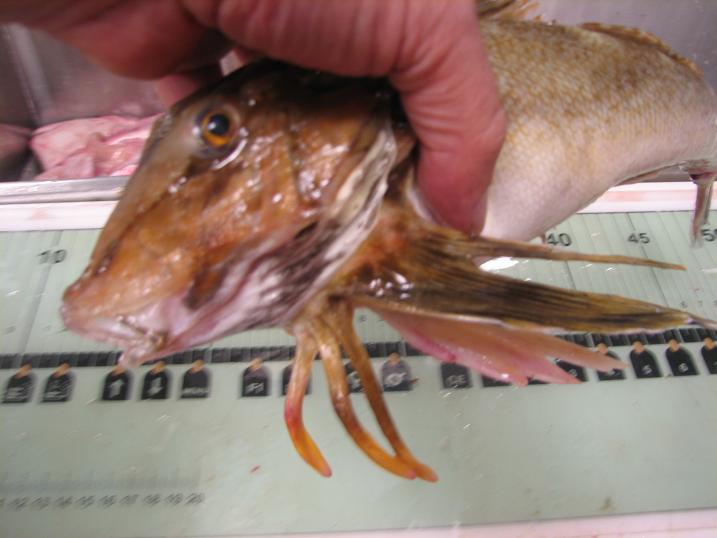
These two baby dog-fish show different stages of development. This one is still connected to an egg sack. The other has broken loose from it, but you can still see where it was attached just below the mouth. Usually in this species, just like most fish in the shark family has eggs that develop inside the mother's body. She gives birth to the pups when they have hatched from their eggs and are ready for the open sea.
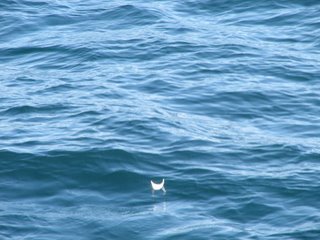
Finally, we were visited by some dolphins last night. They were eating smaller fish and as they came in for their attack, you can see the smaller fish jumping straight out of the water into the air to try to avoid being caught. Click here for a video.

Snuggy and Zee decided to visit the kitchen today. Here are Zee and Snuggy with our chief Steward Dennis M. Carey and our 2nd cook, Alexander Williams. The food here is fantastic. See how large the kitchen is? We have a lot of people to feed on this ship, and the cooks here work hard. You have seen a few of the many different jobs that people can do on a ship like this. You have seen the scientists at work in the labs, you have seen the engineers who make the engine go. You have been to the bridge where the NOAA Corp officers run the ship. You have been to the kitchen where the cooks keep us so well fed. Tomorrow, you will see how the deck crew trawl our sample nets through the water. Keep checking the blog this weekend. There will be lots to see.
Now, some answers to your questions and comments:
Hi to KD and to Derek Jeter. We are staying safe. Thanks for writing.
Hello to St. Mark School in Florida. I'm glad you are enjoying the blog. I really enjoyed your thoughts about what these fish have in common. Great work. Here are some answers:
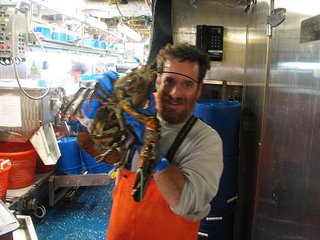 If a ship hit a drifter, the drifter would probably be broken. But the ocean is a big place, and that does not happen very often.
If a ship hit a drifter, the drifter would probably be broken. But the ocean is a big place, and that does not happen very often.
Did any fish try to bite me? Yes. One scallop closed its shell on my finger. I had to be quick to get my hand out of the way in time. Other than that, no.
At 8 knots per hour, the ship could travel 192 knots, or about 220 miles in a day.
Oh, and to all those who asked, so far I have not gotten sick. Yet.
Amazing creatures keep coming up in our nets day after day. Let's take a look at a creature called a skate. The skate makes those funny black rectangles that you find on beaches. Take a look at where those rectangles come from and what is inside of them. Click here for a video!
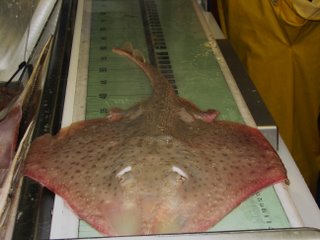
Skates also have interesting faces. They live along the bottom of the sea. Their eyes are on top of their head to spot predators and their mouthes are below to eat what is on the bottom. They have two nostril -like openings above their mouth called spiracles. They look just like eyes but actually help the skate breathe. Here are a few interesting skate faces.
This sea robin uses three separate parts of its pectoral fin, called fin-rays to move, almost like its walking along the bottom of the sea as it looks for food. This helps is move very quietly, making it able to sneak up on prey unobserved.

These two baby dog-fish show different stages of development. This one is still connected to an egg sack. The other has broken loose from it, but you can still see where it was attached just below the mouth. Usually in this species, just like most fish in the shark family has eggs that develop inside the mother's body. She gives birth to the pups when they have hatched from their eggs and are ready for the open sea.
Many people have asked me about garbage. Here is some of what we have found so far. We caught part of someone else's fishing net. Here is a Styrofoam cup and here is a plastic bag, which we caught 140 miles from the nearest land. How do you think it got here?
Finally, we were visited by some dolphins last night. They were eating smaller fish and as they came in for their attack, you can see the smaller fish jumping straight out of the water into the air to try to avoid being caught. Click here for a video.
Snuggy and Zee decided to visit the kitchen today. Here are Zee and Snuggy with our chief Steward Dennis M. Carey and our 2nd cook, Alexander Williams. The food here is fantastic. See how large the kitchen is? We have a lot of people to feed on this ship, and the cooks here work hard. You have seen a few of the many different jobs that people can do on a ship like this. You have seen the scientists at work in the labs, you have seen the engineers who make the engine go. You have been to the bridge where the NOAA Corp officers run the ship. You have been to the kitchen where the cooks keep us so well fed. Tomorrow, you will see how the deck crew trawl our sample nets through the water. Keep checking the blog this weekend. There will be lots to see.
Now, some answers to your questions and comments:
Hi to KD and to Derek Jeter. We are staying safe. Thanks for writing.
Hello to St. Mark School in Florida. I'm glad you are enjoying the blog. I really enjoyed your thoughts about what these fish have in common. Great work. Here are some answers:
Can your school adopt a drifter? Of course! Take a look here: http://www.adoptadrifter.noaa.gov/. In the mean time, you are welcome to follow the adventures of our buoy. Keep checking this website!
I have Snuggy because some of my kindergarten classes asked me to take a bear with me to sea. So I did!
How heavy are the drifters? It weight 30 pounds or so, I would guess. Enough to make me work to pick it up.
I knew the whale was dead because part of it was decomposing. We could see it and we could smell it. Yuck.
Did any fish try to bite me? Yes. One scallop closed its shell on my finger. I had to be quick to get my hand out of the way in time. Other than that, no.
At 8 knots per hour, the ship could travel 192 knots, or about 220 miles in a day.
Congratulations to all who calculated correctly. The truth is that we have to stop for sample trawls every hour or two, so we seldom make our top cruising speed when we do work like this. So, we usually travel less than we could.
Oh, and to all those who asked, so far I have not gotten sick. Yet.
Thanks all for writing. Keep checking the blog!
Update: Drifter Deployed!
We have deployed the drifter buoy that we are adopting along with the Seoul American High School in Korea! Remember, a drifter is a device that floats in the water with the currents. It uses a satellite to tell us where it is and what the water temperature is.
Check the shiptracker website to see where we have been sailing. Where do you think the drifter will go? Please post your theories on the blog. Only time will tell who is right. Try researching currents like the Gulf Stream before you post your answer!
Click here for video of the launch. Please note: This is a large file. If you are in a lab, please watch this together on the Smarboard rather than trying to load it on each machine separately.








